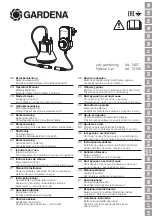
923
060000
_09_01
7
Page
2 from
3
Release the push button and wait. In a few
second the leds will go OFF and the light level
setting is stored in the memory. If the push
button is pressed again to turn ON the leds,
the leds will light with the light intensity that
was selected. The same can be done with the
unit on it’s charging base. This way we can
have a different light level when the unit is on
it’s charging base and a different light level
when the units is not on the base
(or during a
power failure)
.
The light level decreases from
the highest level to the lowest level. In order to
increase the light level, release and push the
button again. Once the desired light level has
been reached, release the push button and the
current setting will be stored into memory after
3 seconds.
This setting is retained into
memory until a new setting is stored.
Battery duration and operation
When the unit is removed from its base, the
charging stops and the unit automatically
enters the backup operation. Observe that the
illumination is automatically increased to the
maximum level. To decrease the light level,
press the push button continuously until the
desired level has been reached. By decreasing
the light level, the autonomous duration is
increased. Each time the unit enters backup
operation, the illumination level is automatically
set to maximum.
If the unit is in backup
operation for a time period that exceeds the
above mentioned times, then the LEDs will go
OFF in order to protect the battery from deep
discharge. In this state the unit is completely
inoperative and a complete 24 hour charge is
required until its next use.
Photo-sensor activation - deactivation
By default the photo-sensor is deactivated.
This means that the unit will light if it is in the
ON state.
If the photo-sensor is activated then
the unit will light only in the dark and if it is in
the ON state. To activate or to deactivate the
photo-sensor follow the same procedure as
mentioned below:
Remove the unit from the charging base.
Press the push button so the white LEDs
turned OFF. Release the button and press
again continuously. In 2 seconds the LEDs will
light. Continue pressing the push button for 6
more seconds until the LEDs blink briefly. If the
photo-sensor function was disabled then with
this procedure it will be enabled. The same
procedure is used to disable the photo-sensor
function.
Mounting on the wall
There are two notches on the charging base
which are used to pass the mounting screws
(figure 2).
Attention
- The luminaire is suitable for indoor use.
- When placing the unit on the charging base,
ensure that the charging LED lights.
- If the unit is not used for long periods of time,
leave it on the charging base in order to keep
the batteries charged.
- Do not mount the unit at a distance of less
than 50 cm from a wall corner in order to avoid
photo-sensor disturbances.
- When placing the unit on the charging base,
align the pins of the unit to the respective pins
on the base and press gently. Do not exert
excess force.
-
Replaced batteries must not be thrown into
trash bins. They must be returned to
special battery disposal points. Do not
incinerate.
- When the mains cable is damaged, this must
be replaced by our SERVICE department or by
an authorized technician.
NOTE!!
After finishing the installation you must
power the luminaire at least for 24 hours for
battery charging to perform the nominal
autonomy.
If the autonomous duration time is considerably
less than nominal, the battery must be replaced
with a new one with the same type.
Battery replacement procedure
(
figure
3).
1.
Detach the luminaire from its base figure
1.
2
.
Unfasten the
2
mounting screws of the rear
plastic and remove it
.
3.
Remove the battery an place a new one with
the same type and connect it as shown in the
picture
.
4.
Refit the rear plastic and fasten the removed
screws in step 1
.





















